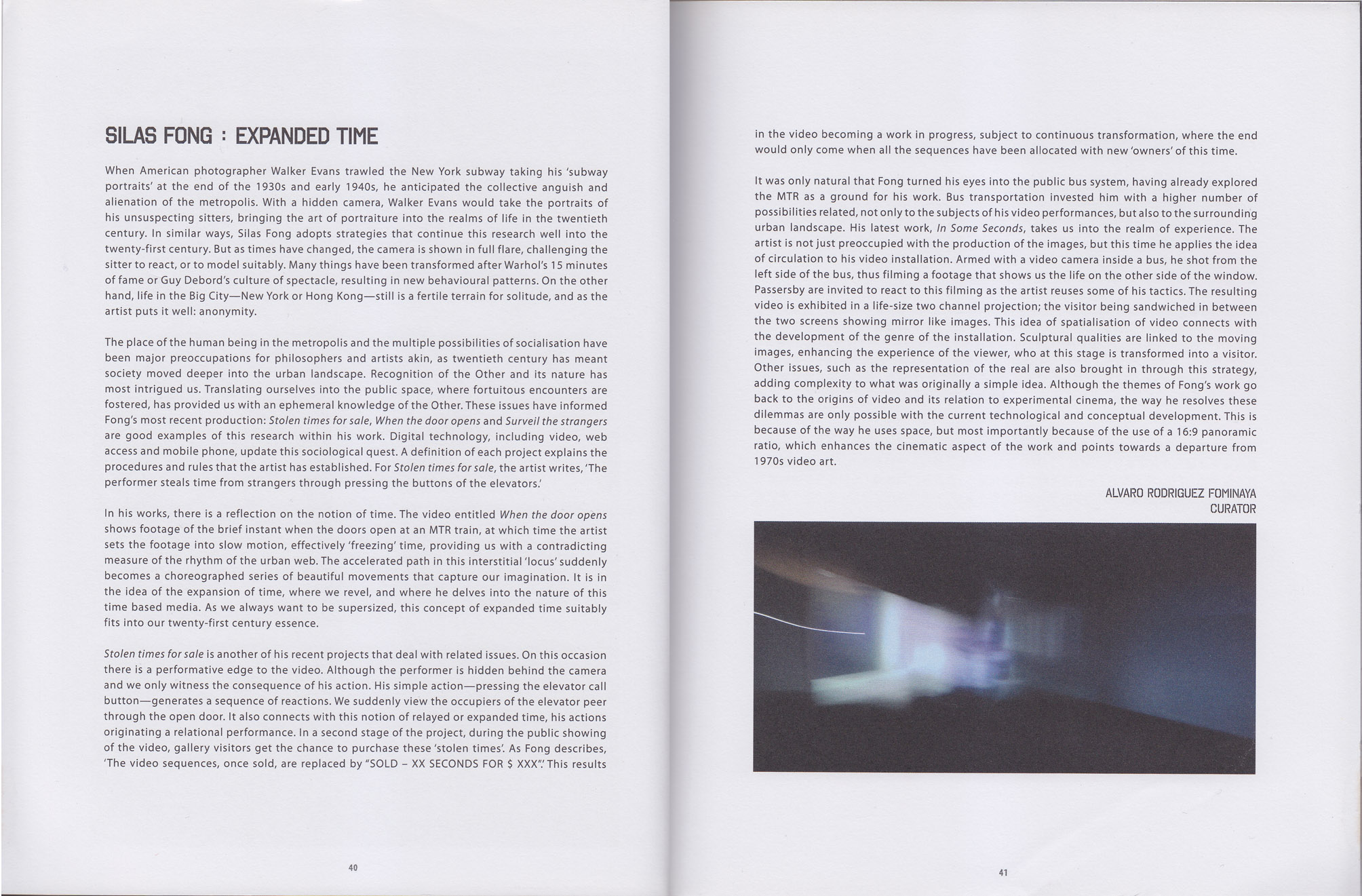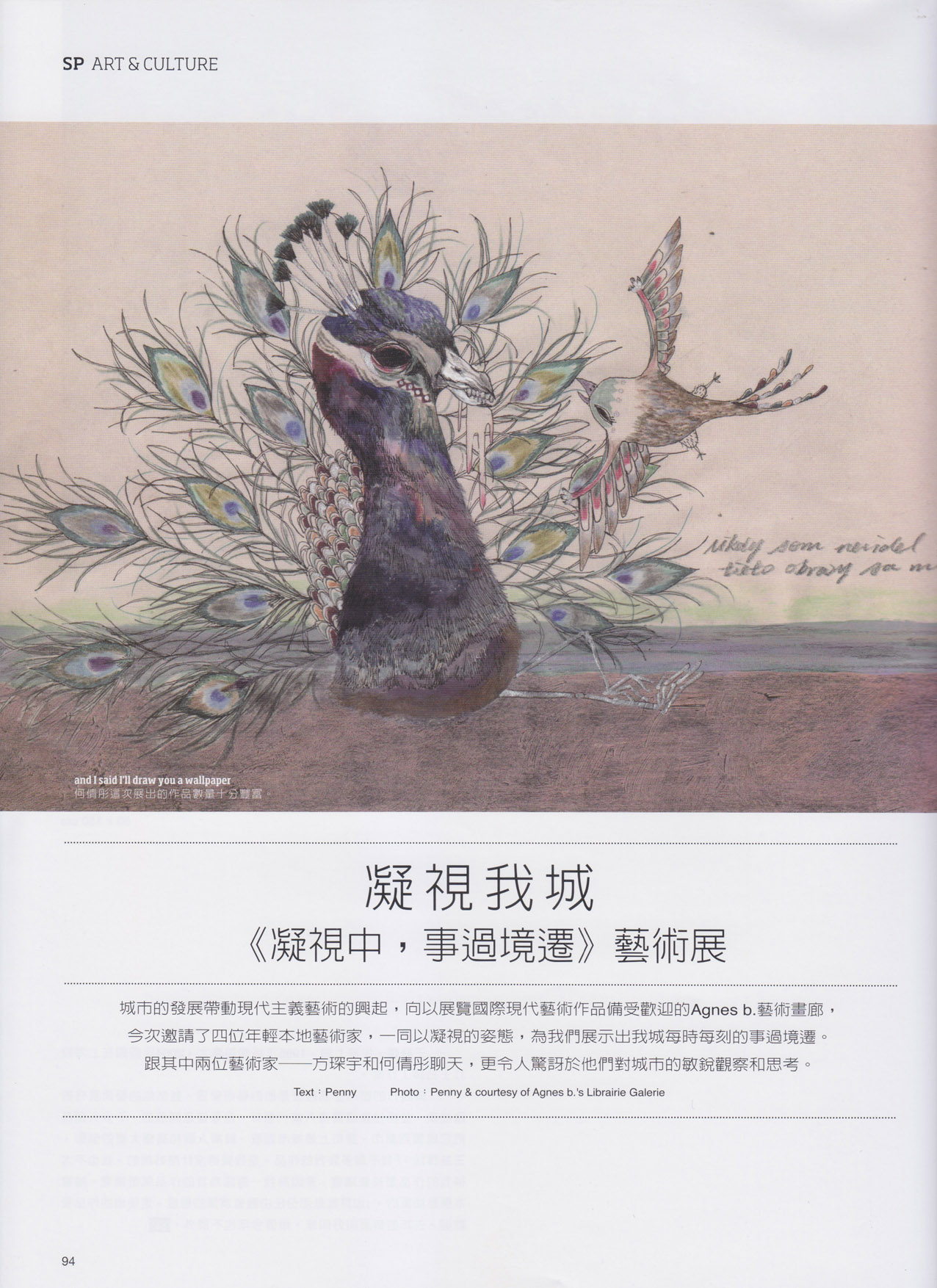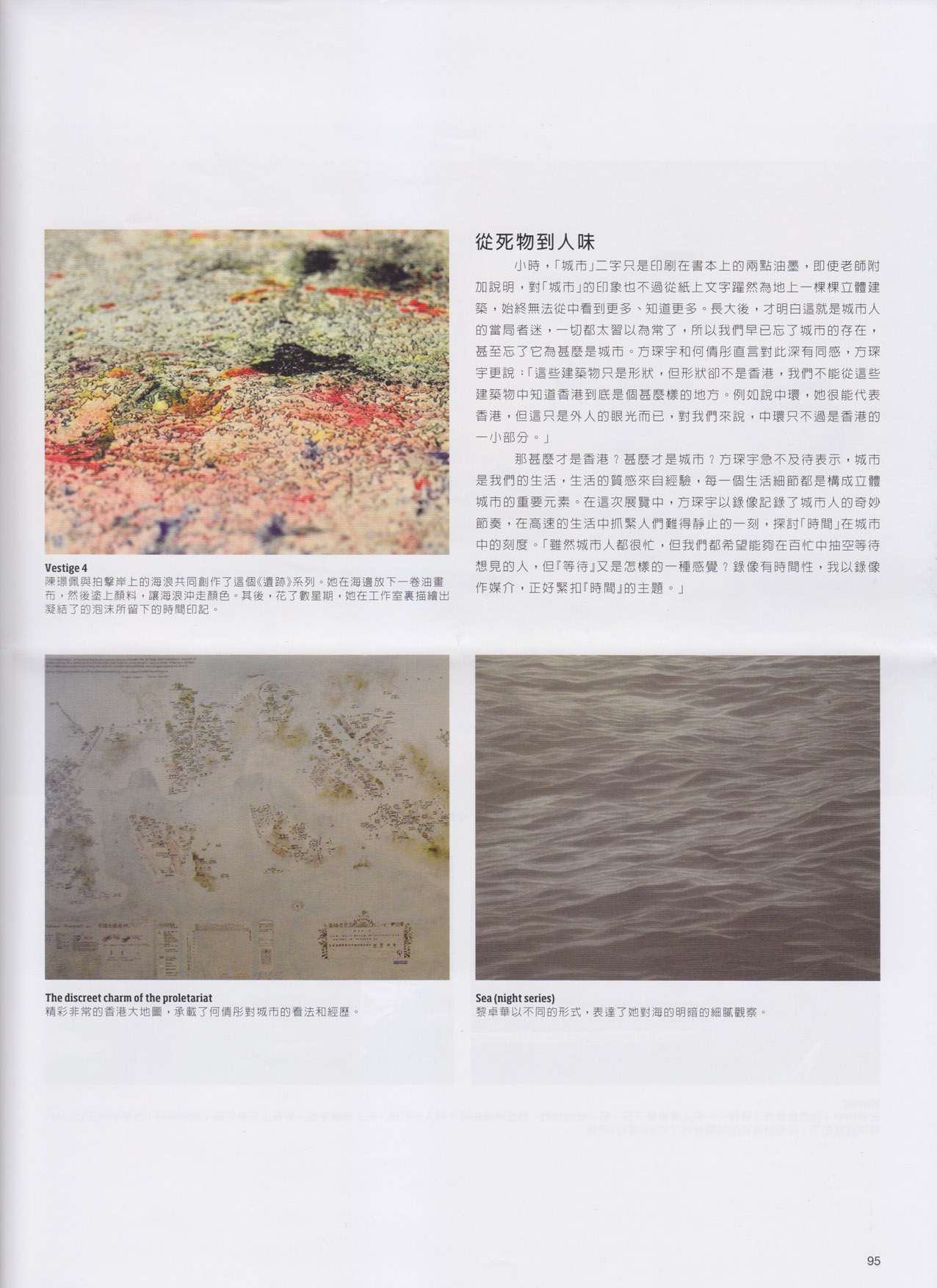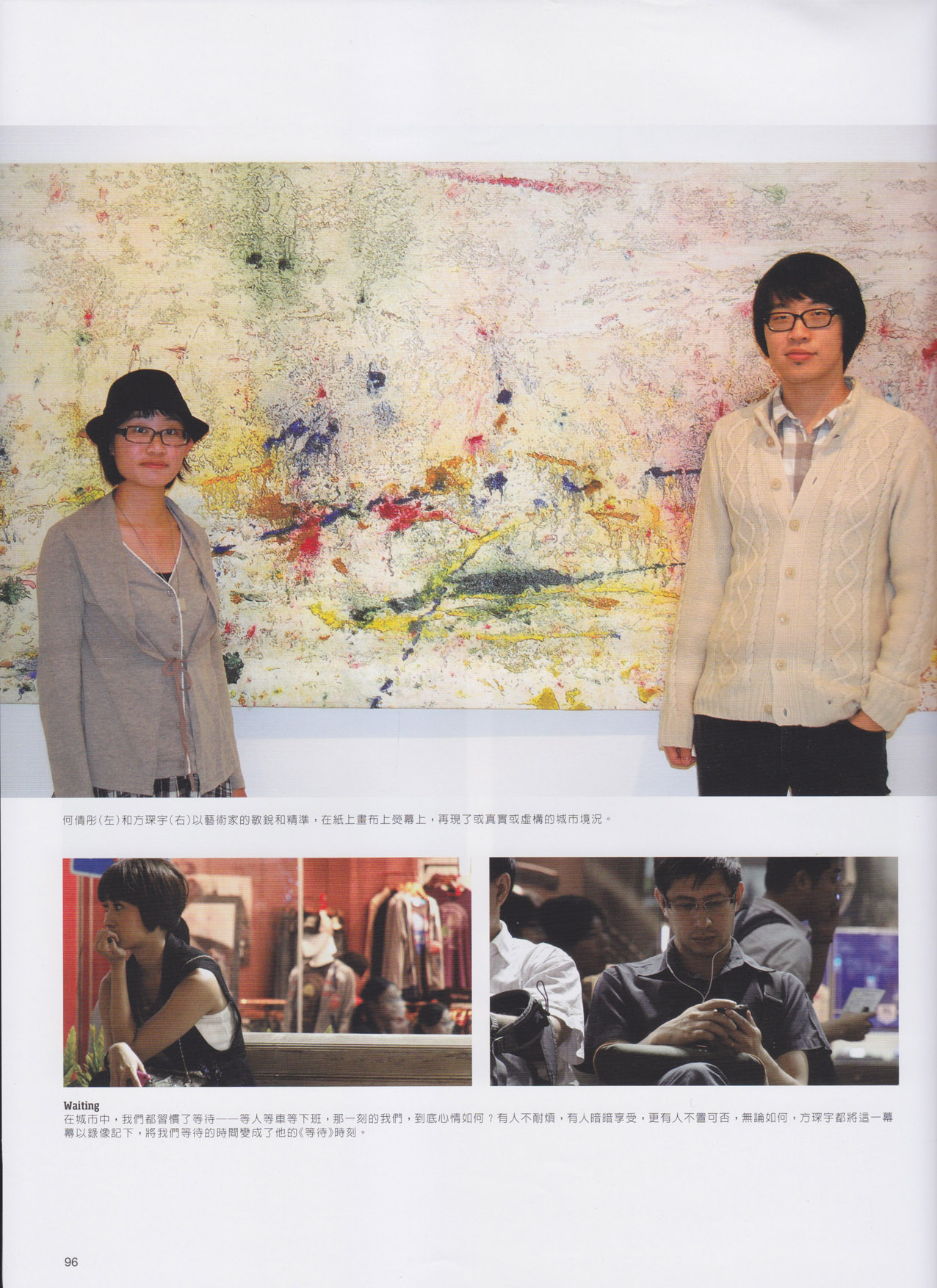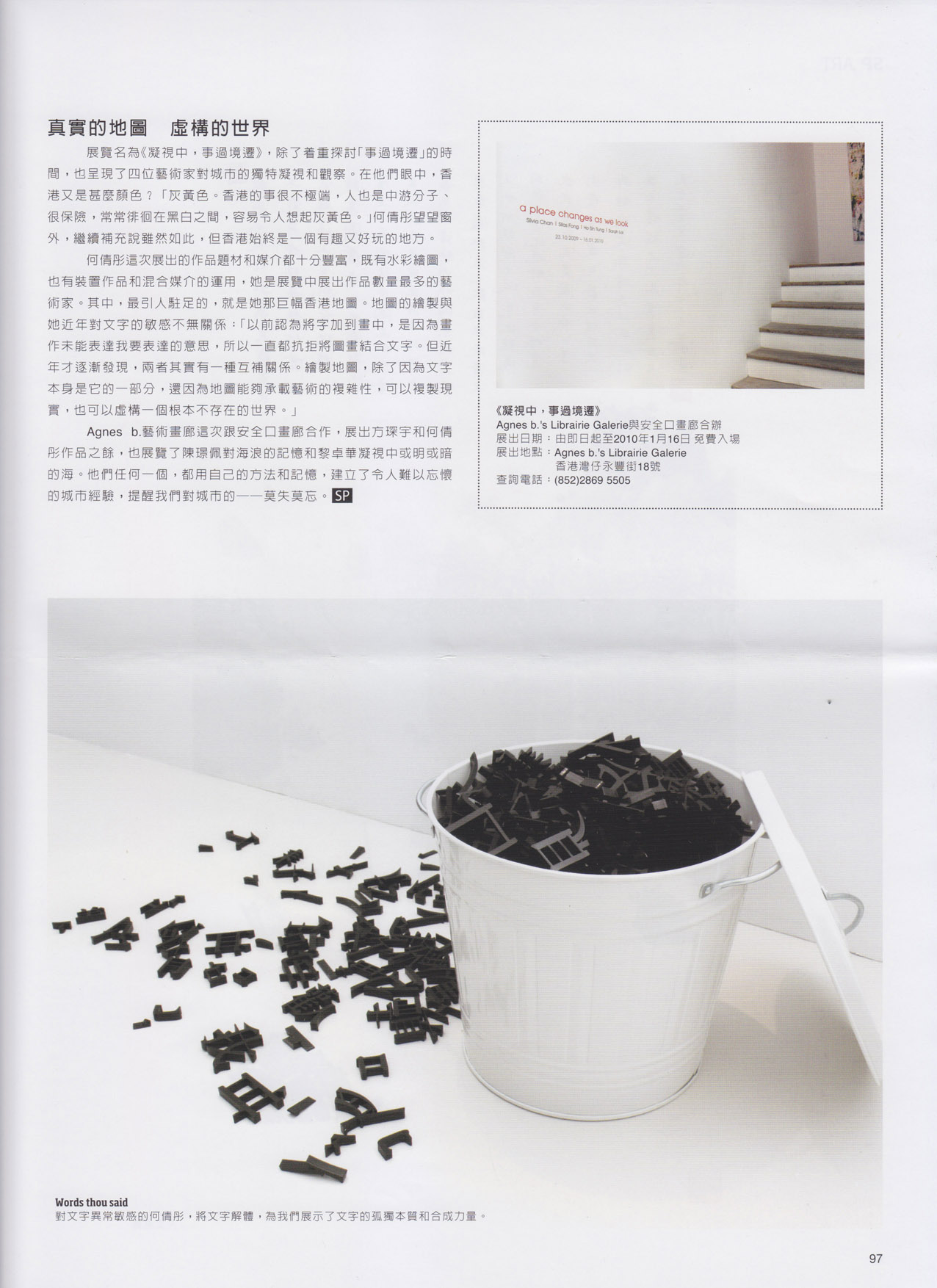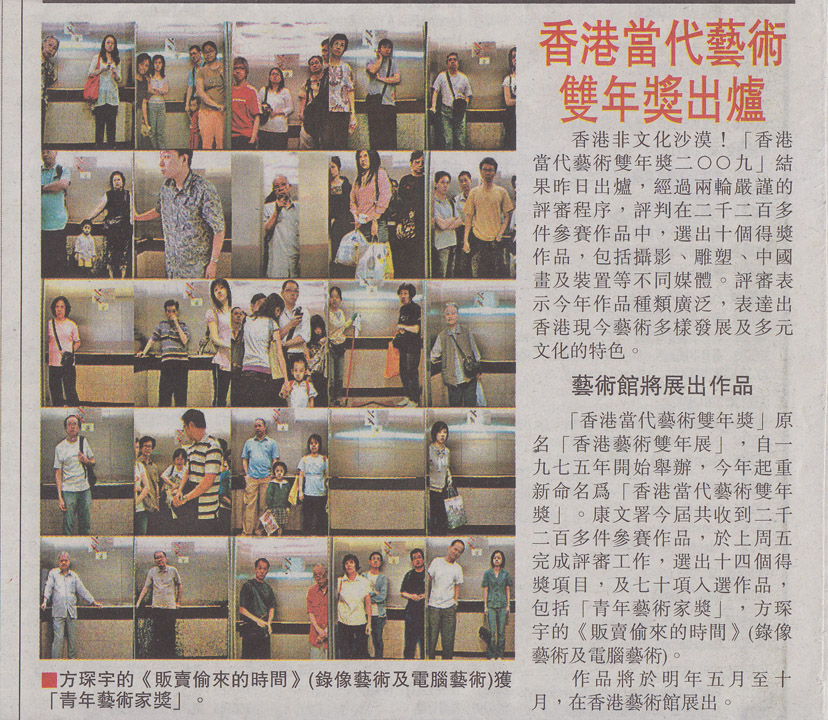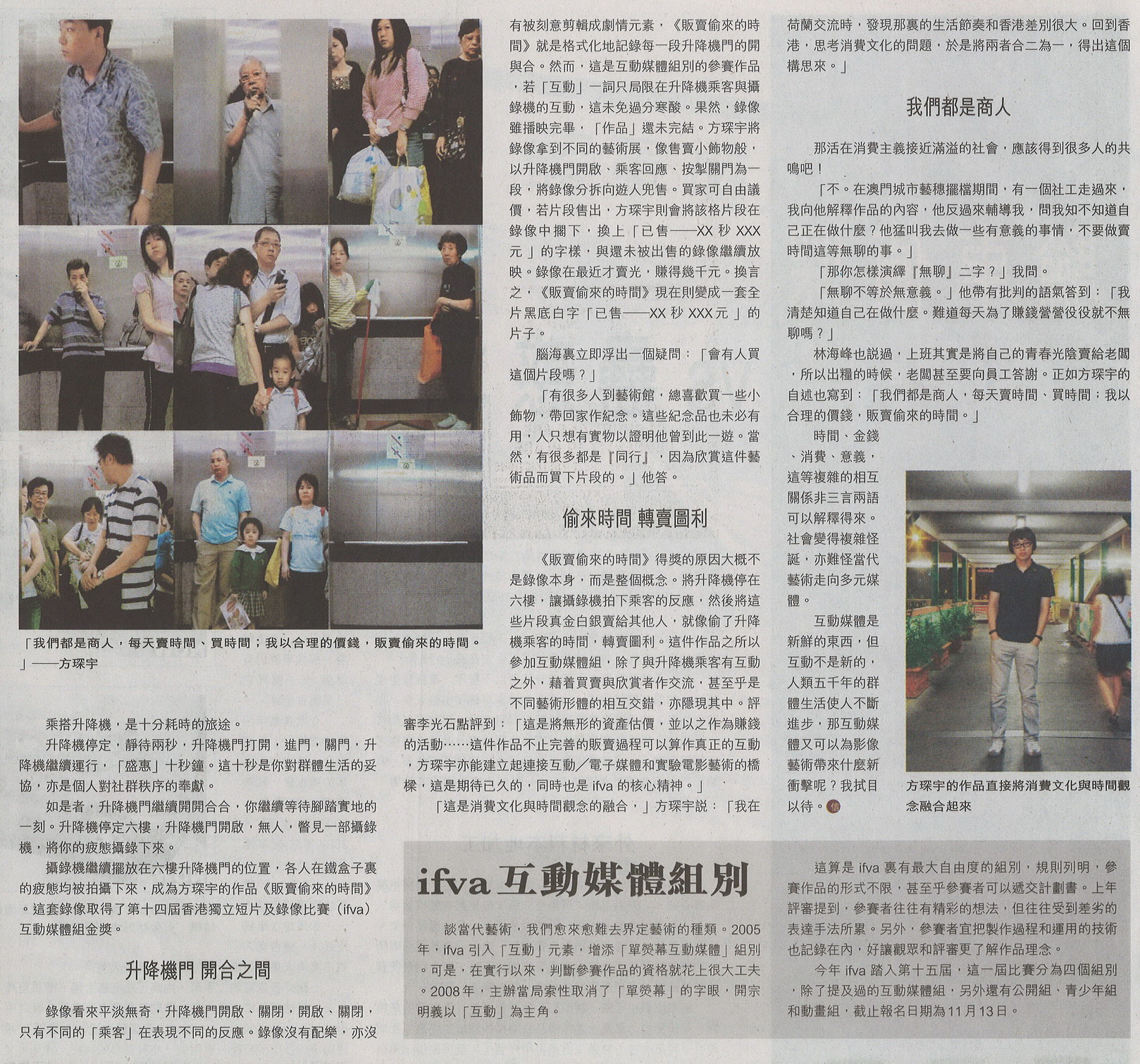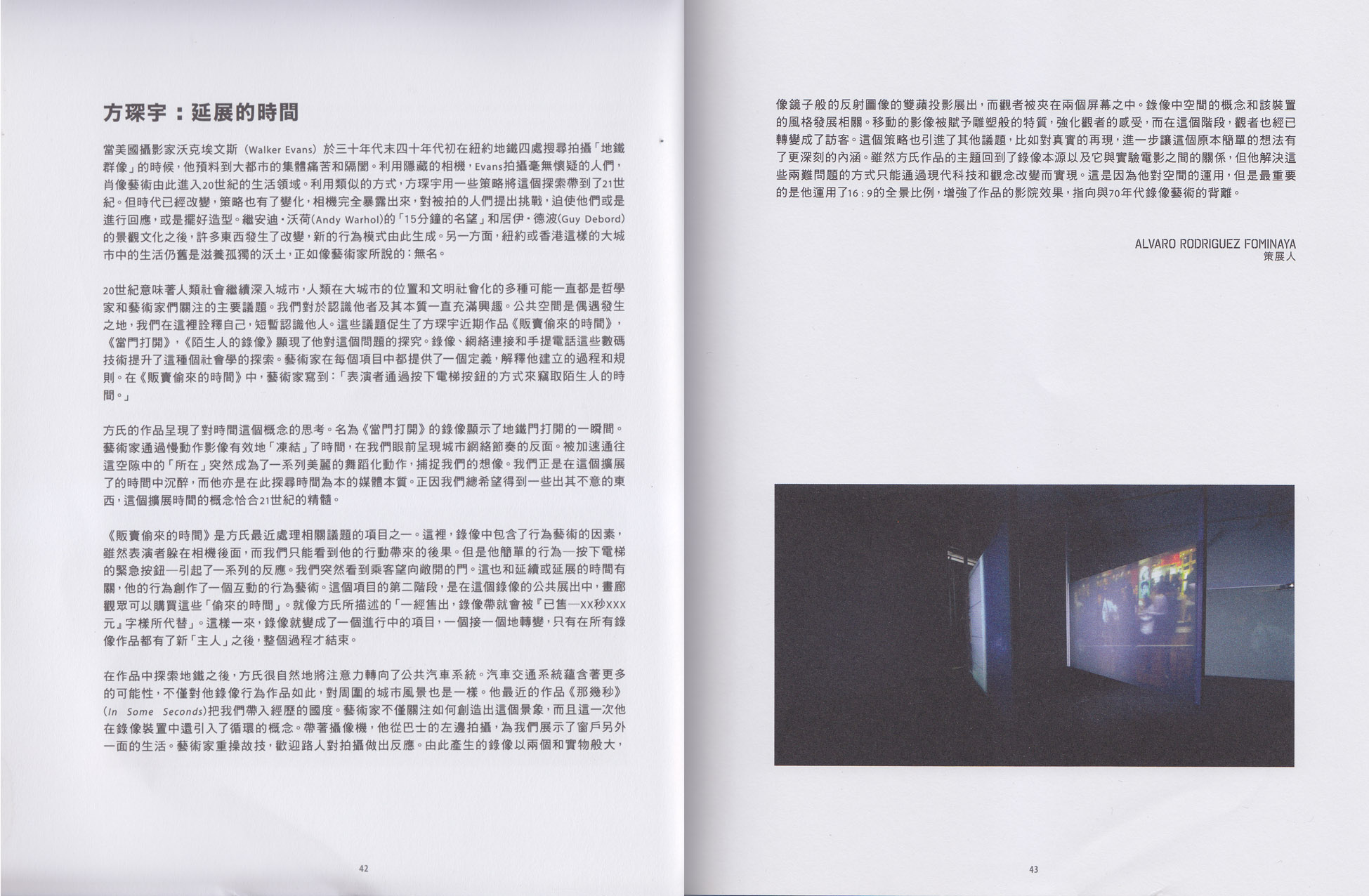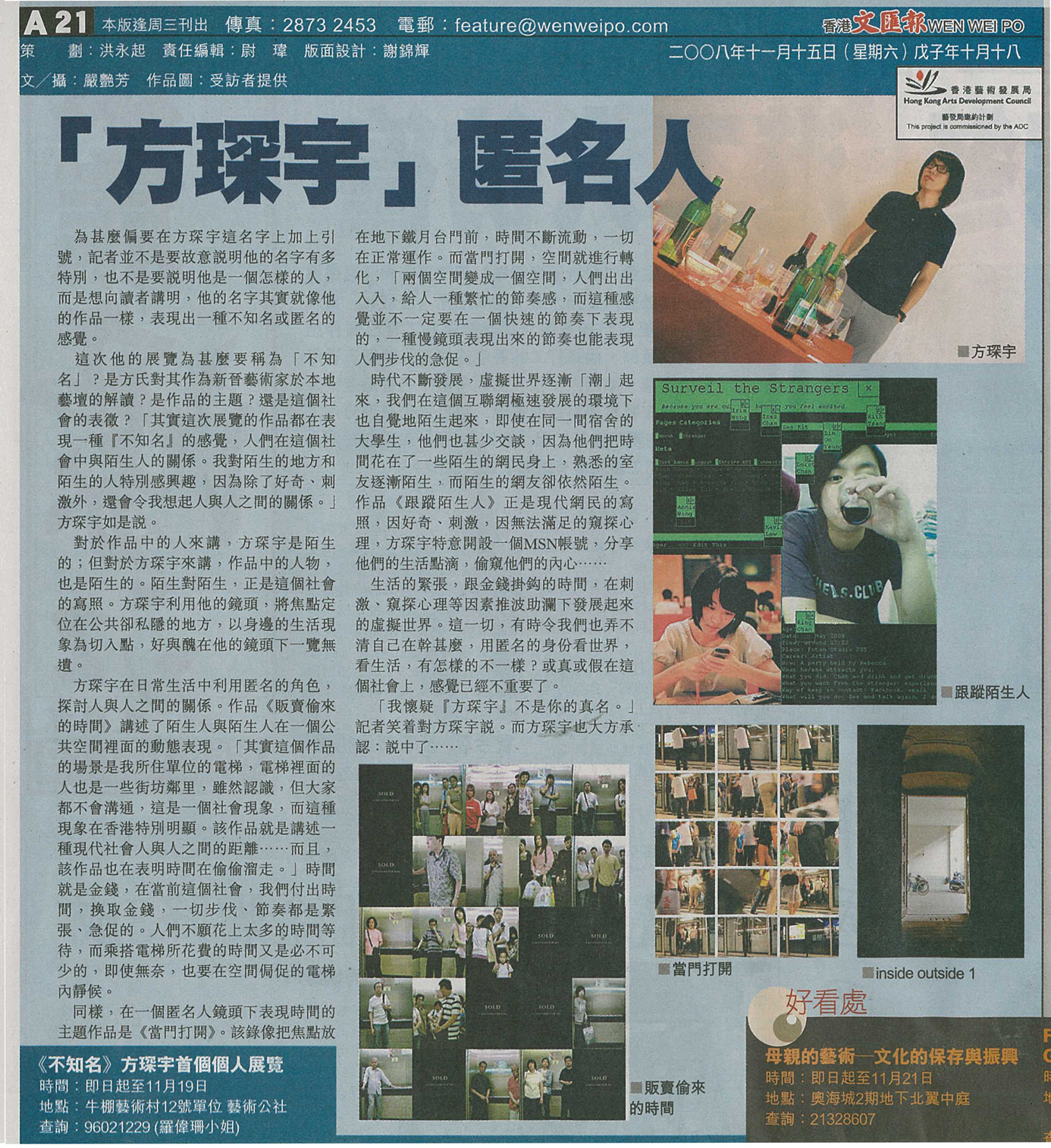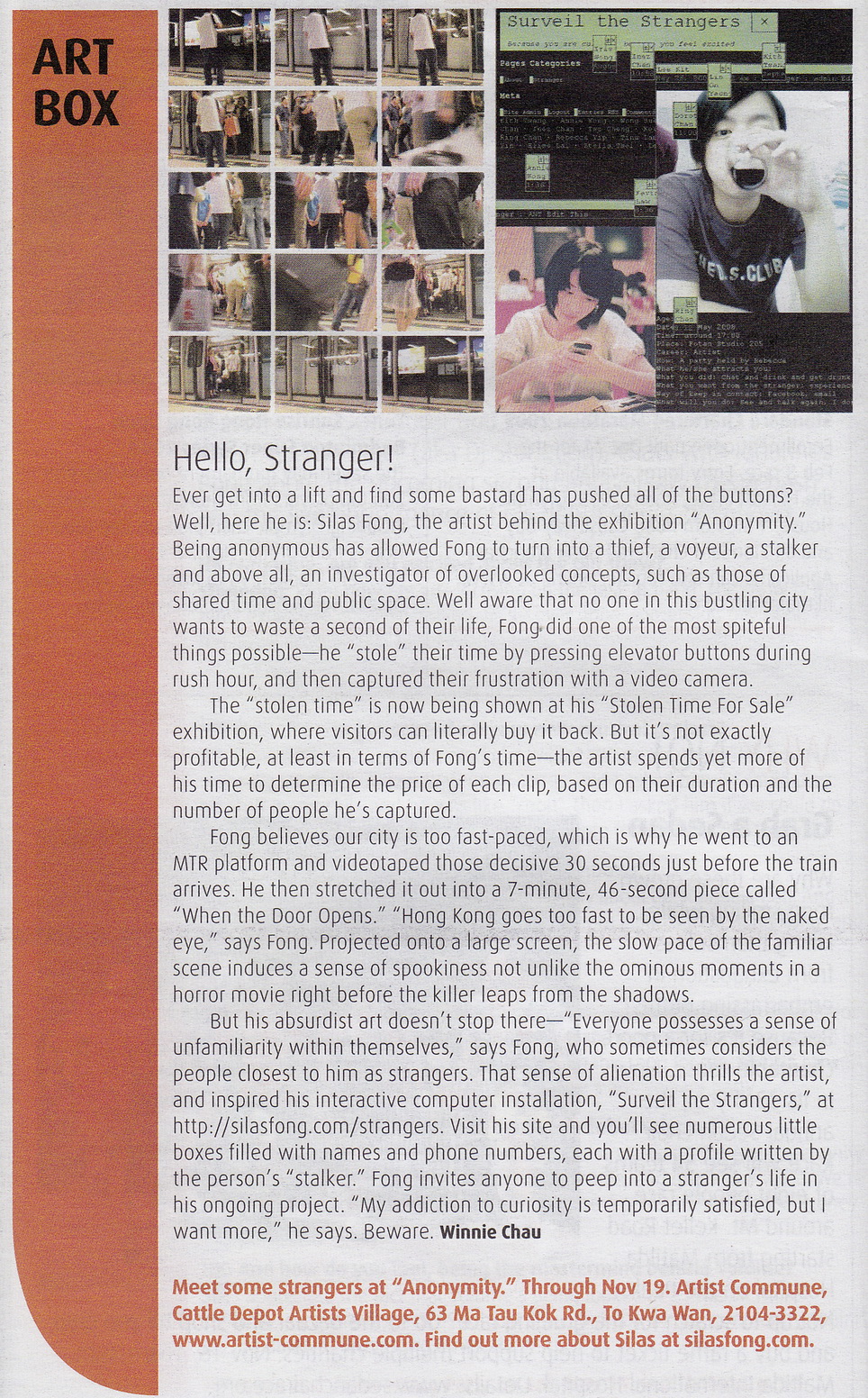Media. Classified Post
Date. 2010-07-30
Page. 6
Text. Wilson Lau
Link. http://www.scmp.com/article/720922/artist-driven-passion
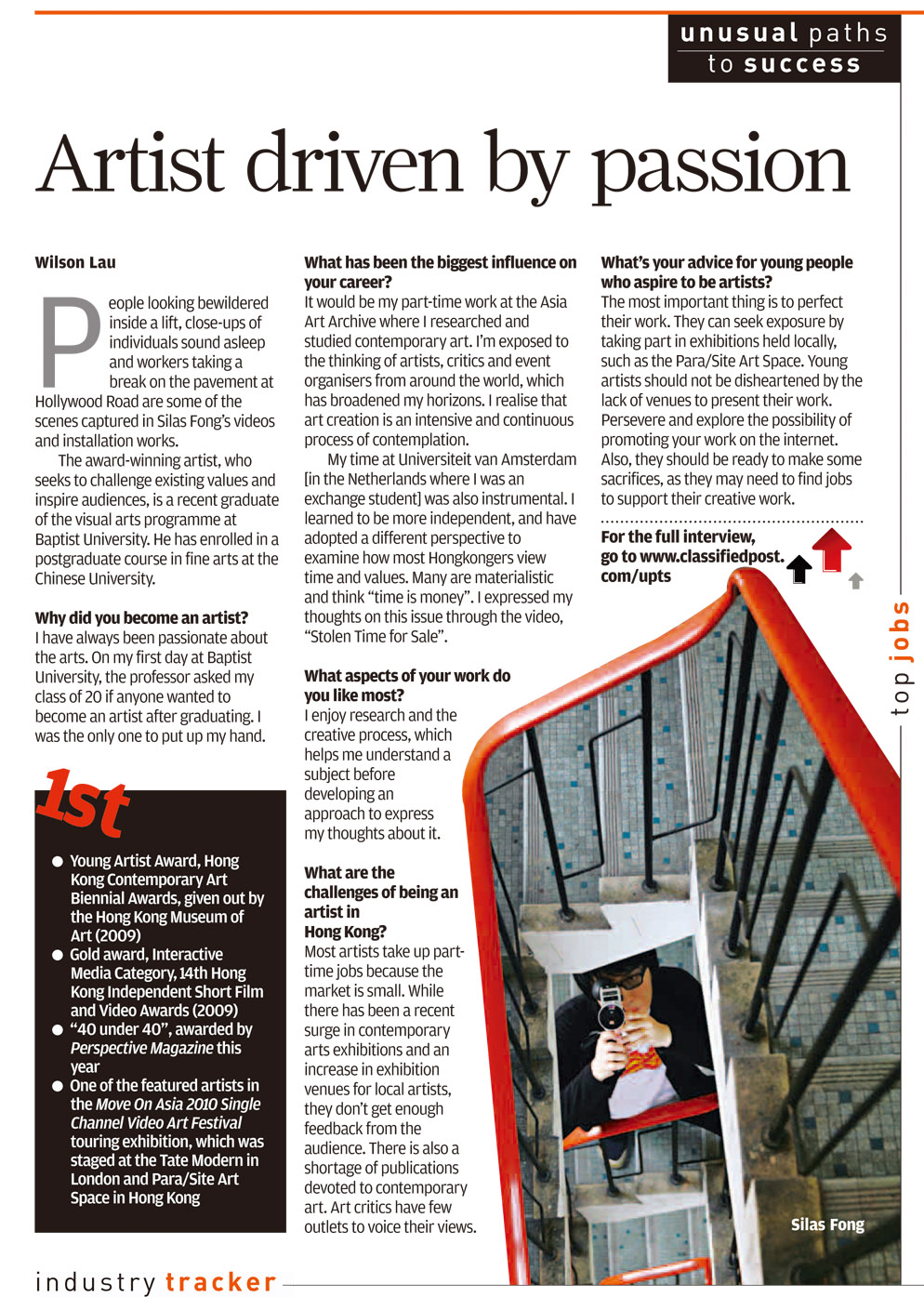
Category: Article and coverage
-
Artist driven by passion
-
Expanded Time
Alvaro Rodriguez Fominaya
When American photographer Walker Evans trawled the New York subway taking his “subway portraits” at the end of the 30s and early 40s, he anticipated the collective anguish and alienation of the metropolis. With a hidden camera, Walker Evans would take the portraits of his unsuspected sitters, bringing the art of portraiture into the realms of life in the 20th century. In similar ways, Silas Fong adopts strategies that continue this research well into the 21st century. But as times have changed, the camera is shown in full flare, challenging the sitter to react, or to model suitably. Many things have been transformed after Warhol’s 5 minutes of fame or Guy Debord’s Culture of Spectacle, resulting in new behavioral patterns. On the other hand, life in the Big City – New York or Hong Kong – still is a fertile terrain for solitude, and as the artist puts it well: anonymity.
The place of the human being in the metropolis and the multiple possibilities of socialization have been major preoccupations for philosophers and artists akin, as 20th century meant society moved deeper into the urban landscape. Recognition of the Other and its nature has most intrigued us. Translating ourselves into the public space, where fortuitous encounters are fostered, has provided us with an ephemeral knowledge of the Other. These issues have informed Silas Fong most recent production: “Stolen times for sale”, “When the door opens” and “Surveil the strangers” are good examples of this research within his work. Digital technology, including video, web access and mobile phone, update this sociological quest. A definition of each project explains the procedures and rules that the artist has established. For “Stolen times for sale”, the artist writes: “The performer steals time from strangers through pressing the buttons of the elevators”.
In his works there is a reflection on the notion of time. The video “When the door opens” shows footage of the brief instant when the doors open at a MTR train, at the same time the artist sets the footage into slow motion, effectively “freezing” time, providing us with a contradicting measure of the rhythm of the urban web. The accelerated path in this interstitial “locus” suddenly becomes a choreographed series of beautiful movements that capture our imagination. It is in the idea of the expansion of time, where we revel, and where he delves into the nature of this time based media. As we always want to be supersized, this concept of expanded time suitably fits into our 21st century essence.
“Stolen times for sale” is another of his recent projects that deal with related issues. On this occasion there is a performative edge to the video. Although the performer is hidden behind the camera and we only witness the consequence of his action. His simple action – pressing the elevator call button – generates a sequence of reactions. We suddenly view the occupiers of the elevator peer through the open door. It also connects with this notion of relayed or expanded time, his actions originating a relational performance. In a second stage of the project, during the public showing of the video, the gallery visitors get the chance to purchase these “stolen times”. As Silas Fongs describes: “The video sequences once sold are replaced by “SOLD – XX SECONDS FOR $ XXX”. This results in the video becoming a work in progress, subject to continuous transformation, where the end would only come when all the sequences have been allocated with new “owners” of this time.
It was only natural that Silas Fong turned his eyes into the public bus system, having already explored the MTR as a ground for his work. Bus transportation invested him with a higher number of possibilities related, not only to the subjects of his videoperformances, but also to the surrounding urban landscape. His latest work, takes us into the realm of experience. The artist is not just preoccupied with the production of the images, but this time he applies the idea of circulation to his videoinstallation. Armed with a video camera inside a bus, he shot from the left side of the bus, thus filming a footage that shows us the life on the other side of the window. Passersby are invited to react to this filming as the artist reuses some of his tactics. The resulting video is exhibited in a real life size two channel projection; the visitor being sandwiched in between the two screens showing mirror like images. This idea of spatialization of video connects with the development of the genre of the installation. Sculptural qualities are linked to the moving images, enhancing the experience of the viewer, who at this stage is transformed into a visitor. Other issues, such as the representation of the real are also brought in through this strategy, adding complexity to what was originally a simple idea. Although the themes of Silas Fong’s work go back to the origins of video and its relation to experimental cinema, the way he resolves these dilemmas are only possible with the current technological and conceptual development. This is because of the way he uses space, but most importantly because of the use of a 16:9 panoramic ratio, which enhances the cinematic aspect of the work and points towards a departure from 70’s videoart.
-
False Public Space – In a poetic/private tone
Leung Mee-ping
Concerning the works of art on public spaces, there are numerous example in which private spaces are intervened in order to discuss its publicness. Recently there is an artists’ group ‘hijacked’ various local public spheres, redefining the spaces which have been ‘privatized’ by commercial organizations. This literally involves art into our living spaces, but also counteracts the power and changes the reality. Being art or not for such kind of public art no longer makes any significance as it is already a part of the serious yet relaxing livelihood.
Similar to the young artists of his generation, Silas Fong begins with scenes from his daily life. To a certain extent, he engages into public space by works like ‘Stolen Times for Sale’, ‘Surveil the Strangers’, ‘When the Door Opens’ and ‘Opening Performance’. These works portray the people, known and unknown, he encountered in his public life, but the people inside did not appear as the same individuals as in the reality. If we define the publicness of his works with references to those who interferes the public spaces, he seemed to be distanced from the real life. The characters in the public space he focuses on or plays with might only be their shadows. Therefore the interpretation of his work is wide-opened while his position, when dealing with space politics, remains vague. For me, his engagement into public space in fact reflected/created his private space of existence. Inside, he slowly tastes his poems, just like the tone he talks in the actual life.
– Published in “Anonymity – The Debut Solo Exhibition of Silas Fong”, Exhibited from 1-19 November 2008 -
偽公共的空間 - 私/詩人的語調
梁美萍
探究公共空間的作品,常以私人空間作為切入點,辯證公共空間的公共性概念。例如早前有藝術家群「騎劫」本土各類公共空間,把原本是屬於「公共」卻被商販 「私有化」佔用的空間重新詮釋,真正地引發了藝術介入現實生活的空間,作出抗衡,改變現實。如此的公共藝術,是否藝術已不再重要,因為它已成為既認真又輕 鬆的生活本身。
像許多年輕一代的創作人,方琛宇亦以身邊的日常生活現象為切入點。可以說,他的作品大部份都介入了公共的空間,如《販賣偷來的時間》、《陌生人網誌》、 《當門打開》和《開幕表演》,作品中呈現了他個人在公共生活中接觸過的人,有認識的或不認識的,這些人物卻沒有在他的作品中展現個別現實的面貌。如果以介 入公共空間的創作來定性他作品的公共性的話,似乎他與現實生活隔了一層。他注意的或者把玩的,也許僅是公共空間人物的影子。既然是影子,他作品的詮釋開放 性則較大,因而,一般同類創作可能引起的空間政治,在他的作品中並不明確。在我看來,他藉介入公共空間反而體現 / 創造了其私人的存在空間。在裡面,他慢慢嘴嚼他的詩,一如他現實生活中講話的語調。– 刊於”不知名 – 方琛宇首個個人展覽” 場刊, 展期為2008年11月1日至19日
